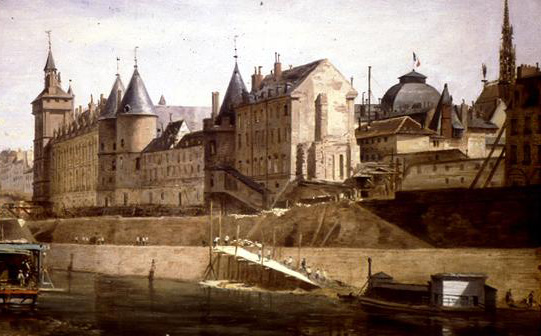|
|||
|
Philatelia.Net / French revolution / Plots / The directory ЂPlotsїThe Conciergerie (La Conciergerie)The Conciergerie is a former royal palace and prison in Paris, located on the west of the Île de la Cité, near the Cathedral of Notre-Dame. It is part of the larger complex known as the Palais de Justice, which is still used for judicial purposes. Hundreds of prisoners during the French Revolution were executed on the guillotines at La Conciergerie. The Conciergerie thus already had an unpleasant reputation before it became internationally famous as the "antechamber to the guillotine" during the Reign of Terror, the bloodiest phase of the French Revolution. It housed the Revolutionary Tribunal as well as up to 1,200 male and female prisoners at a time. The Tribunal sat in the Great Hall between 2 April 1793 and 31 May 1795 and sent nearly 2,600 prisoners to the guillotine. Its rules were simple. Only two outcomes existed Ч a declaration of innocence or a death sentence Ч and in most cases the latter was chosen. The most famous prisoners (and victims) included Queen Marie Antoinette, the poet André Chénier, Charlotte Corday, Madame Élisabeth, Madame du Barry and the Girondins, who were condemned by Georges Danton, who was in turn condemned by Robespierre, who was himself condemned and executed in a final bout of bloodletting. En route to the tumbrils, the victims walked through the Salle Saint-Louis, (Saint Louis Room), which acquired the nickname of the Salle des Perdus, the "Room of the Doomed". After the Restoration of the Bourbons in the 19th century, the Conciergerie continued to be used as a prison for high-value prisoners Ч most notably the future Napoleon III. Marie Antoinette's cell was converted into a chapel dedicated to her memory. The Conciergerie and Palais de Justice underwent major rebuilding in the mid-19th century, totally altering their external appearance. While the building looks like a brooding medieval fortress, this appearance actually only dates from about 1858. The Conciergerie was decommissioned in 1914 and was opened to the public as a national historical monument. It is today a popular tourist attraction, although only a relatively small part of the building is open to public access Ч much of it is still used for the Paris law courts. Comoren Islands, 1989, Dr. Guillotin and Guillotine France, 1947, Conciergerie France, 1947, Herring Gull over Ile de la Cite France, 1989, Madam Roland France, 2010, Conciergerie France, 2010, Conciergerie Ghana, 1989, Street plan of Paris, 1789 Grenada Grenadines, 1989, Boat near Conciergerie Guinea, 2007, Column of Bastille Montserrat, 2001, Theodor Champion and Conciergerie Sao Tome e Principe, 1991, Paris map (1615) France, 1947.04.10Ч30, France, 2010.06.16, France, 2004, France, 2004, France, 2004, France, 1935, France, 1935, France, 1935, France, 1935, France, 1935, France, 1936, France, 1936, France, 1936, France, 1936, France, 1936, France, 2006, Advertising: |
|||
© 2003-2025 Dmitry Karasyuk. Idea, preparation, drawing up
|

